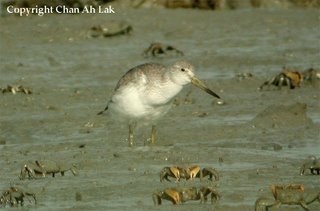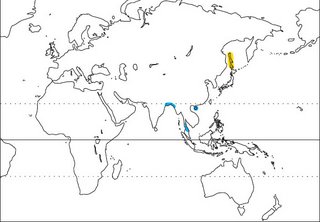(Photo: A Nordmann's Greenshank flanked by closely resembled Common Greenshanks)
 I managed to obtain a permit to visit Kapar Power Station Ash Ponds, Selangor, Malaysia to conduct survey on waders, particularly on my two main targets - Nordmann's Greenshank and Spoon-billed Sandpiper.
I managed to obtain a permit to visit Kapar Power Station Ash Ponds, Selangor, Malaysia to conduct survey on waders, particularly on my two main targets - Nordmann's Greenshank and Spoon-billed Sandpiper.Kapar proves to be a very reliable site for NG. However, we did not manage to spot any Spoon-billed Sandpiper despite scanning thru > 300 Red-necked Stints. (The only official record of SPS in Kapar was a single bird in early 2002)
Kapar is only 1 hour expressway drive from KL. The highlights from 2 days survey on 26 Dec and 27 Dec 2006 during morning high tide are as following:-
Day One 26/12/2006
Ruff - single bird among black-tailed godwits. Orange leg (easily confused with Redshank), short bill and big eyes. Too bad I did not have enough time to ascertain its gender.
Eastern Curlew - one bird flying among a flock of 40+ Eurasian Curlews. Overall dark plumage with same dark rump.
Nordmann's Greenshank - At least 5 birds but hard to id because most stood with their heads tucked in. This is the 2nd time ever that I had observed Nordmann's Greenshank standing on dry ground. One NG held a twig and chased another NG - is this Courtship display?
 Compare the head-bill pattern and unspotted plumage of the Nordmann's Greenshank (Centre) with Common Greenshanks (behind and left). The brown-headed wader in the far left is a Black-tailed Godwit
Compare the head-bill pattern and unspotted plumage of the Nordmann's Greenshank (Centre) with Common Greenshanks (behind and left). The brown-headed wader in the far left is a Black-tailed GodwitDay Two 27/12/2006
Nordmann's Greenshank - About 15 birds - 13 birds counted side by side among a large group of waders. There were a few individuals with more prominent white eyebrow. Could this be first wintering juveniles?
Red Knot - 3 birds among hundreds of Great Knots.
Caspian Tern - 31 birds, an unusually high count.
Common Redshank - strangely the most abundant wader in Kapar was very few (~20) on this date. Other common birds observed are:-
Eurasian Curlew
Whimbrel
Bar-tailed Godwit
Black-tailed Godwit
Common Greenshank
Common Redshank
Common Sandpiper
Marsh Sandpiper
Terek Sandpiper
Great Knot
Curlew Sandpiper
Broad-billed Sandpiper
Grey Plover
Greater Sandplover
Mongolian Sandplover
Little Ringed Plover
Little Tern
Gull-billed Tern
Great Egret
Grey Heron
Intermediate Egret
Little Egret


 journey along the most densely populated and polluted region in the world.
journey along the most densely populated and polluted region in the world.





